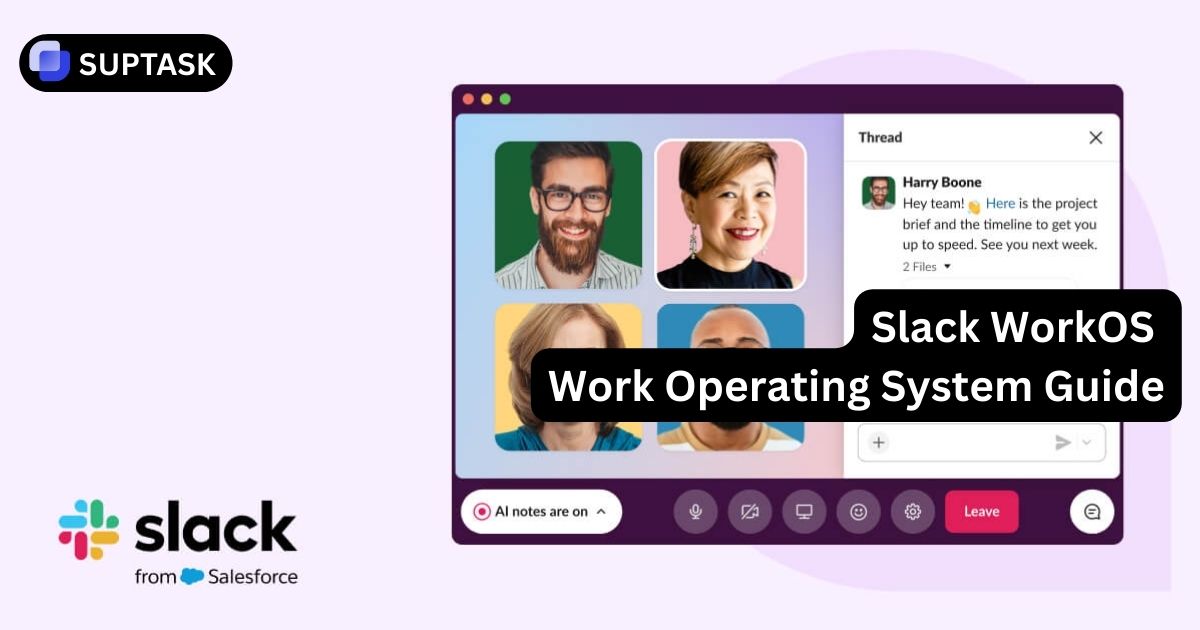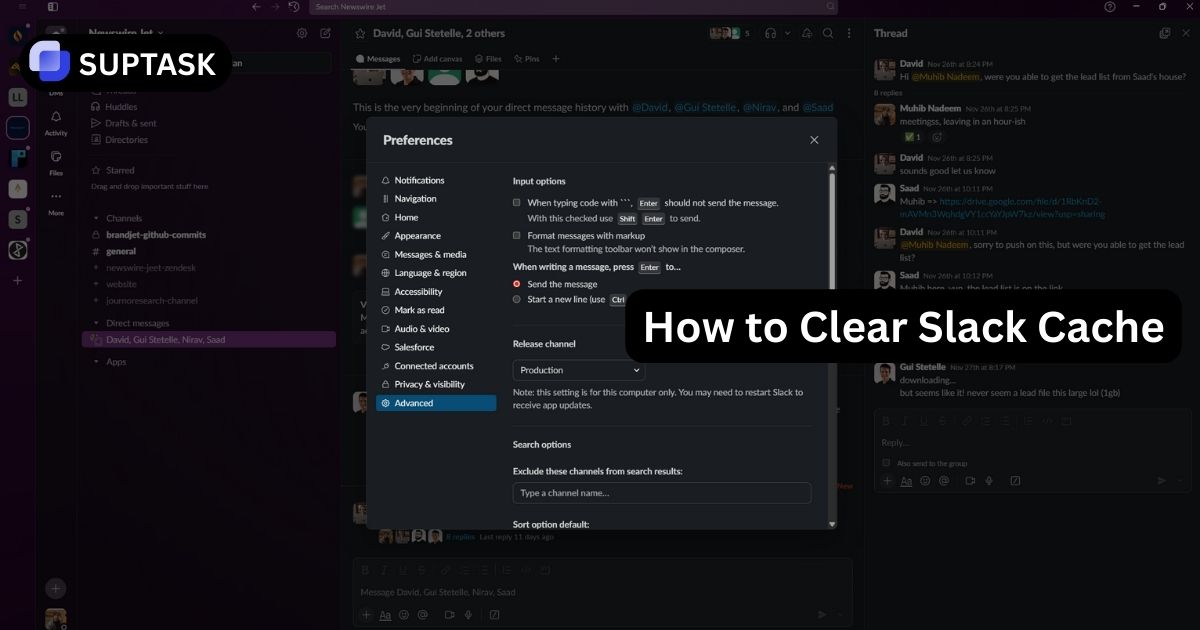As people continue working from home and teaming online, picking the best conversation tool for your team couldn't be more crucial.
Does your team require the formal approach of Slack or the collective style of Discord? Through this simple guide, we'll break down the main points in the "Slack vs Discord" discussion, guiding you to the ideal communication tool for your unique needs.
Exploring Slack and Discord: A Dual Perspective
Slack and Discord, loaded communication apps, attract millions globally. Still, they reach distinct folks for varying needs. Both have text chats, voice and video calls, screen sharing, and link-ups with other apps. But the key asymmetry rests in who they aim for and their main goal.
Discord vs Slack for Community
Discord excels as a platform for building and managing communities. Its focus on voice, video, and text channels allows for seamless interactions among members. Discord’s server customization options, including the use of roles, permissions, and bots, make it ideal for creating vibrant and engaging community spaces. Communities often use Discord for:
- Hosting events and live discussions.
- Organizing members with roles and categories.
- Fostering engagement through custom bots, emotes, and moderation tools.
- Supporting real-time collaboration via voice or video channels.
In contrast, Slack is not community-focused. While its structured environment suits workplace collaboration, it lacks features like persistent voice chat or advanced community-building tools. Therefore, Discord remains the top choice for community-driven platforms.
Discord vs Slack for Business
Slack is specifically designed for business use, offering an organized and professional platform for workplace collaboration. Its features include:
- Threaded messaging for focused discussions.
- Integrations with enterprise-grade tools like Google Workspace, Zoom, and Salesforce.
- Advanced security features for sensitive business communication.
- Paid plans offering unlimited storage and message history.
While Discord can be used for business, its casual and gamer-centric interface is not as well-suited for professional environments. Businesses using Discord may encounter challenges with message organization and integrating enterprise-grade tools.
Slack clearly wins as the better platform for business communications, while Discord remains more of a community-centric tool.
Target Audience and Use Cases
Slack is made for companies, fitting ideally for professional talks. It offers fast messaging, sharing of files, halp ticketing and ties with well-liked third-party tools.
It places Slack as an excellent selection for firms wanting to gather their inside chats and making teamwork smoother.
Conversely, Discord caters mostly to gamers and informal chats. Its standout feature is voice chat. This lets players talk live during game play. Still, Discord's adaptability has attracted diverse groups and individuals beyond gamers. This has turned it into a favorite platform for:
- connecting with like-minded people
- organizing events and meetups
- sharing and discussing common interests
- collaborating on projects
- hosting virtual classrooms or study groups
Both Slack and Discord have transformed since their initial creation. Slack commenced as an in-house tool for gamers to communicate, while Discord sprang from being a chat option in a game to its own entity.
As the years rolled on, both programs broadened in their functions and tailored to a more diverse user base and scenarios.
Slack Use Cases:
.png)
- Professional communication for businesses.
- File sharing and integration with third-party tools like Google Drive, Zoom, and Salesforce.
- Help ticketing and task management.
- Collaboration in enterprise settings with threaded discussions and advanced security.
- Supporting remote teams with structured workflows and integrations.
Discord Use Cases:
.jpeg)
- Real-time voice chats for gaming.
- Hosting virtual classrooms or study groups with screen-sharing capabilities.
- Community building and event organization for hobbies, fandoms, and niche groups.
- Networking for creators and influencers with dedicated servers for followers.
- Running clubs, online hangouts, or team-building sessions with custom bots.
Communication Dynamics in Slack vs Discord
For communication styles, both Slack and Discord shine in separate areas. Slack is terrific at organizing and communicating through text, while Discord is great for voice and video functions.
Text Chat Proficiency
Slack is great at text chats, shown by its tidy, easy-to-use layout. It uses things like threads, direct messaging and ability to schedule messages. This keeps the main screen clean while letting users check out detailed info in threads.
Contrarily, Discord seems to favor voice and video interactions. Still, it provides text chat options using Markdown style and Discord Threads. These tools support multiple chat topics in one channel, simplifying conversation management in bigger servers.
Voice and Video Capabilities
Discord is superb for voice and video capabilities. Its immediate voice chat and dedicated voice chat rooms make it a go-to for players and laid-back chats. The free version of Discord also supports video group talks for up to eight people. Paid versions, however, can accommodate as many as 25 users.
Unlike Discord, Slack is primarily about text chat and organization. It just launched Huddles - a feature similar to Discord's continuous audio channels. But, it allows only two users in its free version. Calls between users are possible on Slack, but it's not their primary function.
Feature Showdown: Slack vs Discord
Analyzing Slack versus Discord involves looking at their layout, how user-friendly they are, and their methods of storing and finding messages. By thoroughly inspecting these parts, you can determine the best platform for your group’s requirements.
Interface and Usability
Slack's straightforward and adaptable layout offers an easy-to-use journey for all users. The customization features let you adjust the platform to suit your group's necessities and desires, crafting a smooth user interaction.
On the flip side, Discord sports a relaxed, game-focused setup. True, it has customization options, but they lean more towards individual tastes. Even so, Discord's server and friend handling tools outshine Slack's, making it a solid choice for particular scenarios.
Message Retention and Search
Slack and Discord both have features to keep and search messages. But, the search tool in Slack is better. With it, you can look for specific words in:
- Conversations
- Files
- Channels
- Other users
Discord, the free version, keeps messages for a long time. But Slack's free version only stores normal and scheduele messages from the past 90 days. Discord has a search feature too, but it's not as good as Slack's. Slack's search function can find way more.
Integration Ecosystem: Extending Functionality
Slack and Discord hard-wire apps and bots to add more features. We'll check out Slack's app store and Discord's user-made bots, highlighting the unique ways they integrate things.
Slack's Extensive App Directory
Slack proudly presents a large app library, which provides more than 2,400 individual apps. These apps aim to boost efficiency and ease workload. They serve various purposes, ranging from managing projects to assisting customers.
- Tettra
- Polly
- Box
- Google Drive
- Workast
- Zoom
- Trello
- Donut
- Slack for Gmail
- Zapier
Some apps may require a subscription fee, but these costs are clearly indicated. You can also use a Slack ticketing system to improve your workflow. Try Suptask free version.
Discord's Community-Created Bots
.webp)
Discord uses bots made by its users to boost how well it works. These bots help with many things, like games, fun stuff, making sure things run smoothly, and making tasks automatic.
In the realm of Discord and other related tools, individuals are capable of using bots and webhooks.
These help post messages from different sites and let bots send automatic messages. It might be true that the bot system of Discord isn't as large as the app directory of Slack, but it still presents an array of possibilities to upgrade what the platform can do.
Pricing Plans: Free vs Paid Options
We'll be taking a look at how Slack and Discord's cost options rake up, covering both free and purchasable plans. We're going to point out the differences in prices for these two, and how it affects the user's experience.
Slack's Tiered Pricing Model
Slack has four pricing options, including a free one to the Enterprise Grid choice. Different features come with each level. For example, Pro users can access past messages and make group video calls.
Keep in mind, Slack's no-cost version does have restrictions unlike Discord's cost-free one. For instance, only the last 10,000 messages are accessible on Slack, but Discord Free offers a limitless message archive.
Discord's Approachable Free Version
.webp)
Discord doesn't charge for various functions like Slack does. You'll find text messages, audio talks, video calls, forming and joining servers, sharing screens, sending files, and making your own emojis all without a fee.
While Discord presents some fee-based options like Discord Nitro and Discord Classic, it's gratis offering is more suitable for limited groups and gatherings. This positions Discord as a more wallet-friendly option for individuals with restrained financial capacity or needing fewer intricate capabilities, especially considering a free package's existence.
Control and Customization: Building Your Space
Slack and Discord provide ways to build and handle online areas. They let you maintain control and customize. We'll look into making each platform unique.
Creating Your Brand Experience on Slack
Slack gives you lots of control and ways to make your brand experience fit you just right. You can make your workspace your own by changing it up:
- Brand colors
- Custom profile fields
- Organized sidebars
- Custom emojis
- Custom Slack theme
The choices for personalizing make it simple for groups to set up a single, uniform look on Slack. Alongside the site's chatting abilities, building a fruitful, cooperative space that fits your group's requirements has never been simpler.
Personalizing Your Discord Server
Discord gives tools to build different and appealing locations for users and communities. While it might not have as many choices for customizing like Slack, it still gives opportunities to tailor your server through:
- Color schemes
- Light and dark modes
- Header images
- Custom emojis
- Icons
- And more
Discord's personal settings make it popular for folks wanting a laid-back, game-focused space. With its chat tools, Discord provides a fun, adaptable spot for people to link up and engage.
File Sharing and Collaboration Tools
Sharing files and working together are important parts of a team communication platform. We'll compare how Slack and Discord handle file sharing, and how this impacts teamwork.
Slack's File Management System
.webp)
Slack provides a strong file handling system. It includes a handy file manager, speedy file sharing, pairing with cloud storage services, and an organizational format ideal for projects.
You can simply drag files into Slack or utilize the 'upload file' function to share files from your PC. After a file is uploaded, you can circulate it in channels or personal messages. Teammates can view, download, and give feedback on it.
Also, Slack offers a lookup tool to find particular documents using key terms or file names. This simplifies the process of locating and arranging files on the platform.
Discord's File Sharing Flexibility
Discord allows you to share files more freely than Slack. Both offer file-sharing, but Discord's cost-free version has an 8MB limit on file size. If you choose the Nitro plan, this limit is boosted to 100MB.
Even though Discord's file sharing might not be as extensive as Slack's, users can still share documents. This makes Discord an ideal choice for relaxed chats and gaming groups. They don't need too many advanced file sharing tools.













